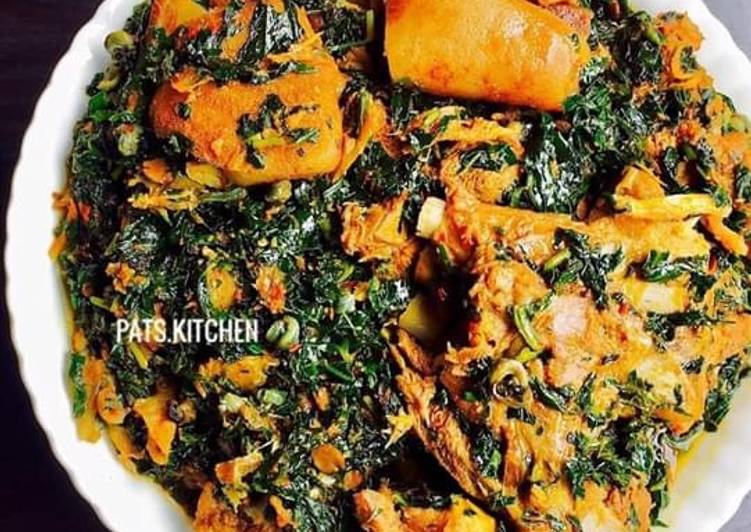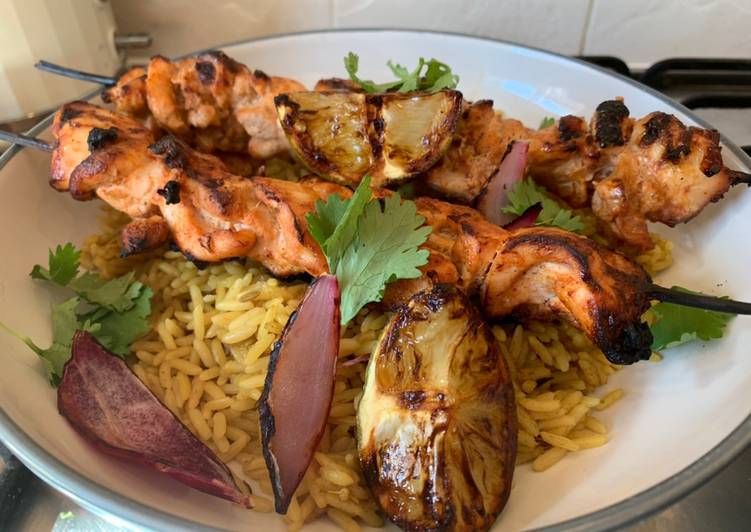
Hello everybody, I hope you’re having an incredible day today. Today, we’re going to prepare a distinctive dish, edikang ikong soup. It is one of my favorites. For mine, I will make it a little bit tasty. This will be really delicious.
The Nigerian Edikang Ikong soup or simply Vegetable Soup is native to the Efiks, people from Akwa Ibom and Cross River states of Nigeria. It is a general notion that the Edikang Ikong soup is very. Edikang Ikong soup is usually served with Usi(Starch),Pounded Yam, Eba, Fufu, Wheat meal (Tuwon Alkama), Semolina or Amala.
Edikang Ikong Soup is one of the most well liked of current trending meals on earth. It’s easy, it’s fast, it tastes yummy. It is enjoyed by millions daily. Edikang Ikong Soup is something that I have loved my entire life. They’re nice and they look fantastic.
To begin with this particular recipe, we must prepare a few ingredients. You can cook edikang ikong soup using 11 ingredients and 6 steps. Here is how you can achieve that.
The ingredients needed to make Edikang Ikong Soup:
- Take Meats of your choice
- Prepare Pumpkin leaves two bunch
- Get Water leaves three bunch
- Make ready Fresh atarodo pepper
- Get as needed Crayfish
- Get Periwinkle
- Prepare Stockfish pieced
- Get Bonga fish pieced
- Prepare as needed Palm oil
- Prepare cubes Seasoning
- Prepare to taste Salt
Edikang Ikong / Edikaikong soup is a nutritious Nigerian soup recipe made with a generous amount of fresh leafy vegetables, dried fish and assorted meat. It is actually one of the native soups of the. What are Edikang Ikong soup ingredients? It's a very specific Nigerian soup that originates from the native Efic lands.
Instructions to make Edikang Ikong Soup:
- How To - If you're using stockfish, dry Catfish, rinse them thoroughly with warm water and set aside. If it's the hard stockfish, put in a bowl, add warm water to it for sometime to reduce the hardness
- Make sure to slice your leafs and rinse thoroughly. Keep in separate sieve to drain water before you proceed with your cooking. - - Have your meats cleaned thoroughly. Steam the meats with seasoning cubes and salt as needed
- Make sure the water is reduced considerably or no water at all, at the end of the steaming. - - Blend your pepper and crayfish with very little amount of water or use dry blended pepper and crayfish. - - When the meat is done, add the blended pepper and crayfish to the meat.
- Add the stockfish, dry fish, bonga fish, Locust bean if using to the pot contents. - - Add palm oil and stir to combine. - Cover the pot, and to steam further for a little time - - Add the water leaf at this stage and allow to steam. Don't cover the pot again. Stir to combine
- The water leaf will give you the little water you need to absorb the pumpkin leaf. - - Add the pumpkin after about two minutes. Don't cover the pot - - Add your cleaned periwinkle to the soup. - - Allow to steam further until fully incorporated. - - Add seasoning cubes and taste for salt.
- You may not need much salt because of your seasoned meats. So watch it… - - Drop from heat when fully cooked with the oil showing up.
It's made out of a range of very interesting ingredients. A famous Nigerian soup, particularly indigenous to the Efiks and thoroughly enjoyed and appreciated amongst connoisseurs and lovers of good food all over the country. Edikang Ikong soup is a soup recipe made with a generous amount of fresh leafy vegetables, dried fish and assorted meat. It is native to the people of Cross River and Akwa Ibom states. Edikang Ikong is a native vegetable soup popular among our brothers from the south namely Akwa Ibom and the cross-River state of Nigeria.
So that is going to wrap this up for this exceptional food edikang ikong soup recipe. Thank you very much for your time. I’m sure that you can make this at home. There is gonna be more interesting food at home recipes coming up. Don’t forget to bookmark this page in your browser, and share it to your loved ones, colleague and friends. Thanks again for reading. Go on get cooking!


